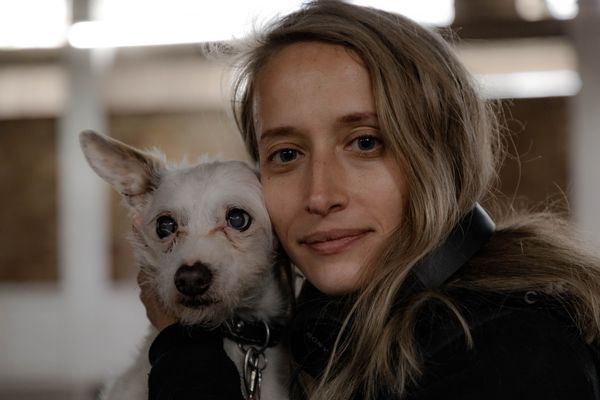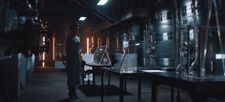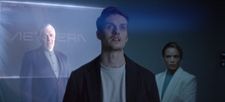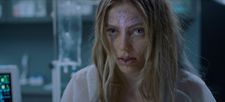 |
| Kelsey Egan, director of The Fix and Glasshouse, with her dog, who also makes an appearance in The Fix Photo: Benjamin Reisner |
As a film critic focused on independent cinema, I see a lot of first features, and I’m always looking out for new talent, but in over 30 years of doing this job I’ve only seen a handful of débuts as fully realised and impeccably crafted as 2021’s Glasshouse. I was delighted at the time to get to talk to its director, South African/American Kelsey Egan, and equally happy when, this month, I learned that she had a new film, The Fix, screening in the closing slot at the Chattanooga Film Festival.
Kelsey was happy to catch up, and we chatted about the trilogy of science fiction films which she had originally planned on making, and how she had run into delays – a common issue in the industry. The Fix, however, struggled more than most.
“I wrote the first draft of the script in 2013, and as I worked to try to get it financed and packaged over years and years, I would be told different things. Every time a new party was interested in coming on board, they would ask for things - such as script revisions or financing terms - and we’d do them, and then they didn't come on board.”
She sighs. As a writer myself, I know how soul-destroying that kind of thing can be – and yet she persisted.
“I undertook and wrote the first draft of the script and countless revisions on spec. We managed to get some development funds for a proof of concept, but for the most part there was no money. I was squeezing in trying to move the project forward while working full time on other productions to earn a living. With Glasshouse, I had the privilege of being committed to it full time and was able to focus all my energy towards it because I was being paid for that development process, whereas The Fix has been a labour of love every step of the way.”
Although it was made on quite a small budget, she creates a really big world through small details, I note.
 |
| Grace Van Dien as Ella in The Fix |
“I'm really glad you noticed that,” she says, thanking me. “I'm really proud of those little details. More time is always beneficial to any creative project, but at the same time, The Fix evolved so much over the years and had so many different voices weighing in, there were many different versions of the film, and I had to decide what mattered most to keep. But if I'm completely honest, I'm probably just a very detail-oriented person, and regardless of the time I get, I always end up being focused on details. It’s just who I am.”
Something about the story that stood out to me, aside from the fact that, once again, there is something wrong with the air, was that when we talked about Glasshouse, Kelsey said that she had been interested in showing the reality behind women who are portrayed as very delicate. The Fix strikes me as doing something similar, particularly because its heroine (Ella, played by Grace Van Dien) is a model, and models tend to be written off as fragile or stupid in most films.
“That was 100% something I was interested in exploring,” she says. “What's weird about the parallel or similarity between Glasshouse and The Fix, with regards to air being a thing, is that I wrote The Fix years before Glasshouse. When Emma and I were brainstorming concepts to pitch, and were coming up with the Glasshouse idea, I was like, ‘Oh, I don't know – is this too close to The Fix? And then we were like, ‘Oh, it's probably fine. It's different enough. It’s a very different world.”
“Off the back of Glasshouse I was lucky enough to finally get the buy in for this project that I've been fighting so hard to make for ten years. So the fact that both worlds have an issue with their air is more a coincidence, than a choice or fixation. But what isn't a coincidence and what you observed very accurately is the theme of 'image' – what we perceive to be true based on external appearances - and it’s something that was very much on my mind with The Fix.”
“I was a massive nerd as a kid. I have -11 vision. My parents noticed when I was around six because I was using binoculars to see things that were only five feet away. And so I got really thick glasses, and I was also a big reader, so I was basically just a huge nerd and got teased a lot. Then the summer before 6th grade, I cut my hair and got contact lenses. When I went to school on the first day, there were a lot of kids there that didn't know me from elementary school because we had two different elementary schools merge.”
“Based just on appearances – not wearing glasses and having a haircut – the first day of sixth grade was the first time I ever received warm, open overtures of friendship from kids I didn’t know. And it was the first time that I was treated in certain ways by boys. It was very weird. I was the same person, right? But these tiny little appearance tweaks made this huge difference to the way the external world was engaging with me. I still remember what that felt like, because it was probably one of the most unsettling, disturbing experiences I've ever had. It made me really think about how much the way we're treated is based on superficial appearances, and how that in turn impacts our worldview, and how we feel about the world, and how we feel about ourselves.”
“Much as we'd like to believe we control our image in many ways, I wonder if we don't. So that really emotionally affected me and has never left me, and it informed how I feel about a lot of issues surrounding representation and demographics and different forms of prejudice that I think are horrifically unfair and wrong. A lot of those ideas were in my mind when I conceptualised The Fix and the character of Ella.”
The other thing that really stands out where women are concerned is that the emotional core of the film is a friendship between two women, rather than a romantic plotline.
 |
| Fleur du Cap nominee Nicole Fortuin as Angela in The Fix |
“Yeah. And for me, the fight between Ella and Gina [played by Robyn Rossouw] is the penultimate conflict in the film. And also the most powerful and beautiful. We worked so hard to get it right. Grace and Robyn really brought it-they knew how important the scene was emotionally, because we all know how pivotal female friendships can be. When the whole world turns on you, that's usually the one thing you have left. Say you get dumped or you're ridiculed or mistreated, it's those core, close female friendships that get you through. But if that female friend also turns on you, it's a whole other level of devastating -because in theory, she knew you best. I wanted to delve into the impact of that – female friendships are just so powerful, and I wanted to show the complexity of these relationships.”
“I hope it resonates with other people– the importance of this friendship. Ella isn't very good at expressing her gratitude or what something means to her, and Grace does such a good job of internalising that and showing Ella’souter façade of giving no fucks and not caring, when actually she caresso deeply. Grace got that balance really well. It's all very subtle and nuanced, and she captures it beautifully. As does Robyn, who is just an incredibly powerful, emotional performer. They’re both so talented, and the day we shot the kitchen scene we were all so moved by it.”
I tell her than that when watching I was thinking throughout that I knew Grace's face from somewhere, and then realised that she has a cameo in Charlie Says, where she's so good that I never forgot it. But Ella is quite a clumsy character in a lot of ways. She's young. She doesn't know what she's doing. She's a bit overwhelmed even before things start to happen to her body, so it's really important that we can see the way she's behaving and who she thinks she is, separately from seeing who she really is as a person.
“Yeah. Her backstory was something we worked really hard on as central to the narrative because, especially in a sci-fi story where so much world-building is required, there are always so many moving parts. The Fix has such a strong ensemble cast – with so many central characters to track – it was really important to clearly set up each character and their relationship dynamics: how and why they matter to one another. We put a lot of thought into this, so I hope the impact of these relationships read as powerfully on the screen as they did in my head. I wish we could have given everyone more screen time - they all deserved it – but pacing was also a big consideration. The film propels you forward every step of the way, just like Ella never really gets a chance to breathe.
We go on to talk about the mutations that Ella experiences after helping herself to somebody else’s drugs at a party.
“Obviously, budget was a massive consideration,” Kelsey says. “A lot of the design was built around how we can save money and how we can be very specific in when we show things and at what stage of the film. So there's different phases to what is happening to her. We were very specific in planning out these phases so that we only reach the final phase in the last act. This way we didn't have quite as many VFX and prosthetics requirements as we would have had her transformation been faster. But we also really leaned into the fact that Ella’s trying to hide what’s going on --”
“She's wearing long sleeves whenever she can. She's trying to cover her body, which feels very realistic and relatable. At first we set her up as a character who shows off her body as the only thing that seems to be valued by others, or at least, the only thing she ever gets any positive feedback on. When she says, ‘Who I am doesn't matter. No-one actually likes me.’ – it’s because she feels that it’s only her external appearance that people respond well to – everything else, no-one really seems to care about. Her wardrobe choices and her bearing at the beginning of the film reflect this. But then, from the moment the transformation starts happening, she's hiding as much as possible. That really saved us from a budget point of view.”
 |
| Something in the air |
There’s all the character stuff going on, and the mutations, but the other thing that really stands out about the film is the quantity and sheer quality of the action.
“I worked for eight years as a stunt performer,” she reveals. “Probably one of the greatest gifts I've ever received in my life was the opportunity to learn and grow with stunt professionals who are infinitely more skilled and talented than me. I fell into it. I started training with my stuntie friends because I wanted to get better at action directing. It was a skill set I wanted to cultivate as a director. As I worked my way up in the industry, I tried to work for as many departments as I could because I figured that to be the best director I could be, I needed to understand where every department was coming from and what they need most from directors to maximize what they can contribute to the overall vision.
“No-one was more shocked than me when this training actually led to stunts castings and getting the opportunity to work as a stunt performer on major sets. I got to audition for Mad Max: Fury Road, and again, and fell out of my proverbial chair when I was selected for their stunt team. I got to participate in the most incredible training and rehearsal process, first in Cape Town and then in Swakopmund, where I doubled for one of the five wives while all the fight choreography was being developed. It was all just so cool, and the whole time, I felt like a total imposter – I’m so grateful I got to have the experience.
“I didn't stay for the whole shoot, but being there for the rehearsal process was remarkable, and I've never lost my passion for that. I’m thrilled anytime I get to do action in anything I do, because I get to reconnect with the stunts family and share what we all love so much. I truly appreciated The Fall Guy. That was such an important film to the stunts community because stunt performers have played such a massive role in movies for so many years, and truly are unsung heroes. It's really meaningful to get some acknowledgement. I get really excited when I can do action sequences with a twist or some special gag as a shout out to the stunt community.
“In The Fix, there's one specific fight sequence with two friends I worked with on Fury Road –both exceptionally talented performers– and we had so much fun choreographing that together. Then next thing I know, both are overseas working on huge movies – one was flown to Australia for Furiosa - and that really hits home how lucky it was that they were even available to come play. I am so grateful to the stunts community because they have always showed up for me. We didn't have the resources of the big studio or streamer shows they typically work on, but despite that, everyone really pulled out all the stops to bring an exceptional level of work, and that means so much to me.
“Glasshouse was a micro-budget film. I tried to throw in some action elements - a few fight beats and tussles - but they’re quite minimal. With The Fix, I was amped to be able to do bigger action sequences, because I feel like more women should get to do action films, right? I hope to be able to direct large-scale action films in future. I've been on big films where the stunt department has been tragically under-utilised simply because the director didn't have the experience to know how to maximize and trust what they could deliver. I get really excited whenever I can help showcase that talent.”
We talk about the work that went into getting the setting right.
 |
| Clancy Brown, Daniel Sharman and Nicole Fortuin in The Fix |
“Our pre-production period was six weeks. Not enough time, but I had a very good sense of what locations I needed because I had this film in my head for so many years. Every time I was working on a set over the years, I’d be like, ‘This location could be great for this...’ So I had a pretty strong sense of where we would need to go to create the Aethera complex, for example, and each different location we needed to use to cobble it together. That was a huge collaboration between locations, action, VFX and everyone, really.
“We did have a ton of locations for such a small film. We needed to make sure we took care of our crew. We were careful with our scheduling to minimise our location moves. We’d beat a location for a few days, and then we’d bein studio for a few days as a bit of a break. We were very cognizant of trying to achieve a balance there. But we also had to work around the locations’ availability – it’s like a game of Tetris to accommodate as many factors as we can.”
I also ask her about her experience of working with Clancy Brown, because for anyone who loves genre film, his presence in the film isan amazing coup.
“That was all down to my exceptional producing partner, Allison Friedman. She was lucky enough to work with Clancy on another indie project of hers called The Mortuary Collection, and we both were so excited about the idea of him as the Chairman. She reached out to him and his team, and they came back with a “yes”! That was an incredible day – it felt like winning the lottery. And then there were all these really really fun synchronicities, because Grace’s Dad (Casper Van Dien) worked with Clancy on Starship Troopers, and then came to South Africa to shoot Starship Troopers 3, so it felt like this brilliant, full circle cosmic alignment with Grace following in her Dad’s footsteps, flying to South Africa to shoot a sci-fi, and sharing the screen with Clancy!
“To be able to work with an actor with his experience and level of craftmanship is a privilege, but he’s also an absolute gem. Both a consummate professional and so warm and considerate - he puts everyone at ease. As a director, I feel it’s my responsibility to sustain a good atmosphere on set, and when you get to collaborate with talent who also make the experience lovely for everyone, it just makes the process that much more fun. Working with Clancy is definitely a career highlight.”
So how does she feel about the film screening at Chattanooga?
“I love this festival,” she says. “It’s basically a father/son operation - the brainchild of Chris [Dortch] Jr., and his father, Chris [Dortch] Sr, who helps him make it all happen. They’re both wonderful - Chris Jnr. is a true cinephile and has developed a reputation for excellent curation, a trait he likely inherited from Chris Sr. and they are both just such warm, caring people. Eclectic, too. Chris Snr. had a long career as a sports journalist, and just happens to have written the 'bible' of college basketball – he was even inducted into the United States Basketball Writers Association’s Hall of Fame. Both father and son have such an authentic appreciation for the impact of science fiction, and they really care about creating an amazing space to celebrate film and support filmmakers.
 |
| Facing the future |
“They really support films they're passionate about, that they feel have value or make commentary on the world or bring something of substance. And their curation is not coming from a political place in any way. They don’t make selections based on ‘Oh, who can we programme to attract the biggest crowd.”. They’re truly about the love of quality cinema, and I was really touched by that. They were so warm and effusive about the film and wanting it for the closing night selection, and that meant a lot to me.”
“If there's anything that I'd love for audiences to know, it’s that the first draft of The Fix was written in 2013. We have this running joke that if we'd managed to get the film made anytime between 2015 and 2019, it would have been seen as omnipotent… whereas now it’ll be considered derivative. Back when Luc Besson's Lucy came out I was so worried, because I feared that it would be too similar and hurt my chances of getting The Fix made – I was so relieved when I watched it and discovered it was quite different. I got turned down so many times over the years, eventually The Fix turned into a bit of a vendetta project, like, ‘Yes, we know it’s ambitious but we also know we can do it… and now we’ve proved it!” It’s truly the best feeling - I'm so grateful that I was finally able to make this movie, and so proud of what we were able to achieve with it.”





















